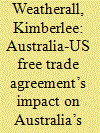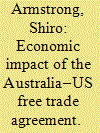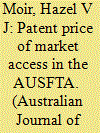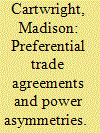|
|
|
Sort Order |
|
|
|
Items / Page
|
|
|
|
|
|
|
| Srl | Item |
| 1 |
ID:
140720


|
|
|
|
|
| Summary/Abstract |
Economists have warned for many years that preferential trade agreements (PTAs) will not necessarily increase economic welfare in Australia given the relatively small size of the economy and the country’s lack of negotiating coin. The Productivity Commission cautioned in its major report on PTAs that there seemed to be a mindset of ‘agreements for agreement’s sake’, in part because of fears of missing out on a bandwagon that has attracted Australia’s major trading partners. Political and security considerations have played an important role in shaping Australia’s approach to PTAs. When politics trumps economics in negotiations of PTAs there is a risk of a rush to premature agreement that produces sub-optimal outcomes, that undermines broader plurilateral and global negotiations, and that introduces new and undesirable distortions in trade and public policies. Various theoretical approaches to trade policymaking provide insights into why Australian governments have been willing to conclude these sub-optimal deals.
|
|
|
|
|
|
|
|
|
|
|
|
|
|
|
|
| 2 |
ID:
140722


|
|
|
|
|
| Summary/Abstract |
The Australia-US Free Trade Agreement (AUSFTA) required extensive changes to Australian copyright law. This paper assesses the impact of these changes one decade on. It considers, first, whether the costs and/or benefits predicted in 2004 have eventuated, finding clear evidence that AUSFTA has undesirably constrained domestic copyright policy, but no clear evidence either of the feared financial costs to society, or, importantly, the touted benefits to copyright owners. The most significant impact of AUSFTA’s copyright provisions, however, appears to have been on Australia’s copyright trade policy. Pre-AUSFTA, Australia promoted multilateral standards and mostly sought to comply with, but not exceed, international IP standards. Post-AUSFTA, Australia has pursued an approach akin to that of the US: endorsing international copyright rules that are significantly stronger, and more detailed. The paper queries whether this shift has been in Australia’s national interest, and raises interesting questions of path-dependence in policymaking and trade negotiations that warrant more, and broader attention in the literature.
|
|
|
|
|
|
|
|
|
|
|
|
|
|
|
|
| 3 |
ID:
140721


|
|
|
|
|
| Summary/Abstract |
The Australia–United States Free Trade Agreement (AUSFTA) came into effect in 2005. It was the second preferential trade agreement that Australia signed, after its agreement with Singapore, and marked a departure from the primacy of Australia's previous trade policy of unilateral and multilateral trade liberalisation toward preferential liberalisation. This paper assesses the economic effects of AUSFTA by applying the Productivity Commission's gravity model of trade from its Bilateral and Regional Trade Agreements review. The evidence reveals AUSFTA resulted in a fall in Australian and US trade with the rest of the world—that the agreement led to trade diversion. Estimates also show that AUSFTA is associated with a reduction in trade between Australia and the United States.
|
|
|
|
|
|
|
|
|
|
|
|
|
|
|
|
| 4 |
ID:
140723


|
|
|
|
|
| Summary/Abstract |
New generation trade agreements reach far behind borders, affecting many areas of domestic policy not previously associated closely with trade. One of the most uneasy of these areas is intellectual property, particularly patent monopolies. The USA has been a major force behind the extended reach of patent monopolies using preferential trade agreements. The patent and data exclusivity provisions of the AUSFTA were proposed by the USA. This paper provides detailed evidence about how such ‘TRIPS+’ policies compare to a balanced patent policy—one equally favouring creators and users of technology. Australia has never had an active patent agenda, but since AUSFTA has been willing to accept in its bilateral and regional trade deals highly prescriptive rules that tie the hands of future governments. The overall trend has thus been toward increasing imbalance, with Australian patent policy now having a very broad reach and very low eligibility standards. This particularly affects the cost of medicines, where large numbers of relatively uninventive patents surround a blockbuster drug and delay the market entry of generic alternatives. In addition to outlining the costs of Australia’s current patent policy approach, the paper concludes by highlighting a more balanced and less costly way forward.
|
|
|
|
|
|
|
|
|
|
|
|
|
|
|
|
| 5 |
ID:
165867


|
|
|
|
|
| Summary/Abstract |
Since the 1980s states have sought to harmonise economic standards to aid the flow of goods, services and finance across borders. The founding agreements of the World Trade Organisation (WTO), for example, harmonised standards on services, intellectual property and investment. However, mutlilateral trade negotiations in the WTO have since stalled. In response, the United States (US) has engaged in forum shopping, using preferential trade agreements at the bilateral, regional and multinational level to harmonise international standards. This article argues that through forum shopping the US has been able to export standards that support the commercial interests of US-based industries more than they encourage economic exchange across borders. Furthermore, because power asymmetries are starker in preferential trade negotiations smaller and middle power states should not enter trade agreements, which include regulatory harmonisation. This is illustrated with the case of the US-Australia free trade agreement, looking specifically at a copyright standard known as technological protection measures (TPMs). It was clear before, during and after the agreement was signed that Australia’s existing standard on TPMs was more popular than the US-style standard. Nevertheless, a US-style standard is in effect domestically because of the trade agreement.
|
|
|
|
|
|
|
|
|
|
|
|
|
|
|
|
|
|
|
|
|